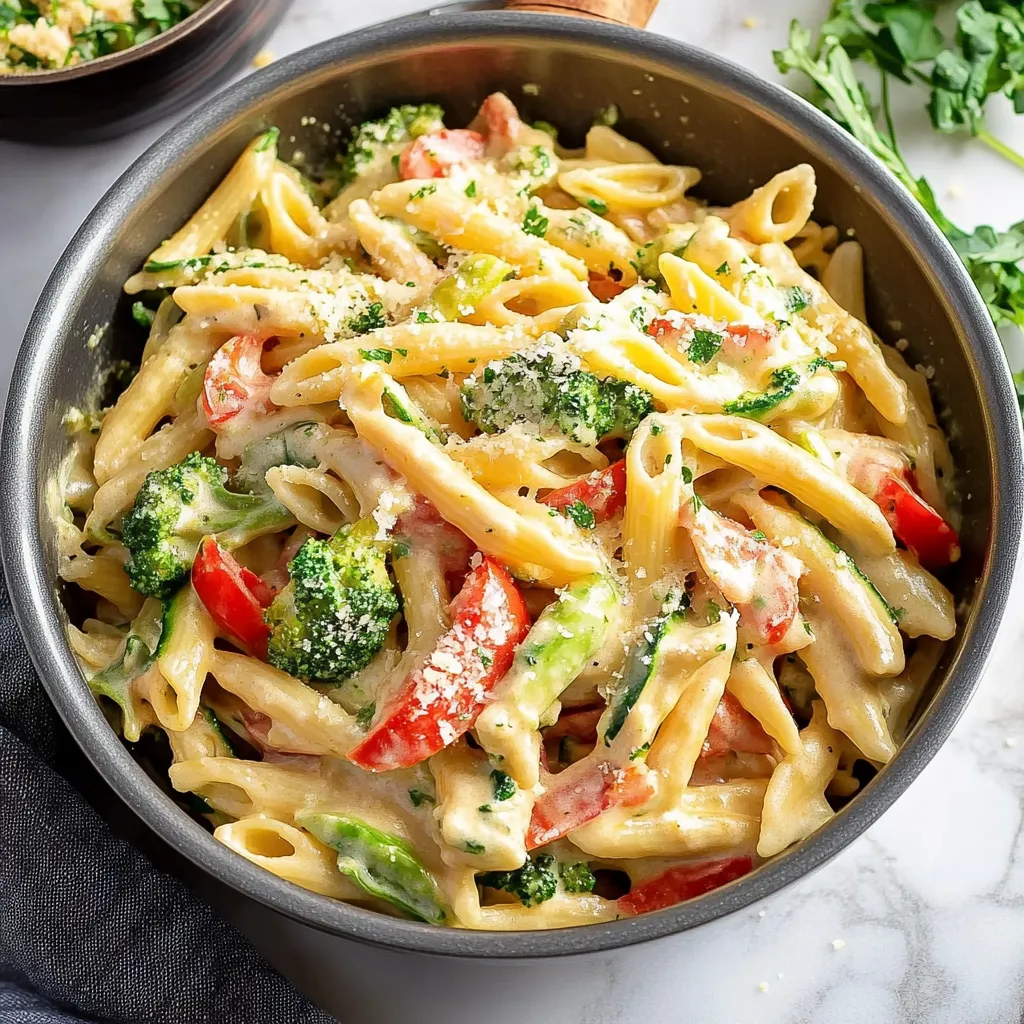 Pin
Pin
This restaurant-quality pasta primavera has a delicious herb cream sauce with penne pasta and a ton of fresh vegetables. There's no better way to get your family to eat their veggies! The combination of crisp, colorful vegetables with a creamy parmesan sauce creates a perfect balance that transforms simple ingredients into something special.
I first created this pasta primavera when trying to use up a bounty of spring vegetables from our garden. My children, usually vegetable skeptics, cleared their plates and asked for seconds. Now it's our go-to Sunday dinner when we want something that feels special but doesn't require hours in the kitchen.
Ingredients
- Chicken broth: Creates the base of our sauce with rich flavor without heaviness
- Half and half: Provides creaminess while being lighter than heavy cream
- Dried herbs parsley, basil, oregano: Create an aromatic Italian flavor profile
- Soy sauce: Adds umami depth that enhances the other flavors
- Hot sauce: Works as a flavor enhancer without making the dish spicy
- Fresh vegetables broccoli, carrots, bell peppers, zucchini: For color and nutrition
- Cherry tomatoes: Add bursts of sweetness when they slightly burst in the heat
- Parmesan cheese: Freshly grated melts beautifully into the sauce
- Lemon juice: Brightens all the flavors right at the end
Step-by-Step Instructions
- Prep the Sauce:
- Combine all sauce ingredients in a measuring cup with a spout. This ensures even distribution of herbs and seasonings and makes it easier to add to the pan gradually. Having this ready before you start cooking prevents scrambling for ingredients once the process begins.
- Prepare the Pasta Water:
- Bring a large pot of water to boil for the pasta. Adding salt to the water is crucial for flavoring the pasta from within. Use about half a tablespoon of salt for a large pot of water to properly season your pasta.
- Sauté the Firm Vegetables:
- Heat olive oil until it shimmers then add broccoli, onions, carrots, and bell peppers. Cook for exactly three minutes which is enough time to soften slightly while maintaining crispness. The vegetables should brighten in color but remain firm.
- Add Delicate Vegetables:
- Introduce zucchini, peas and tomatoes to the pan. These cook faster than the firmer vegetables so they go in later. Season with salt and pepper which draws out flavor and moisture. Cook only 2-3 minutes then remove all vegetables from the pan to prevent overcooking.
- Create the Roux Base:
- Add butter and garlic to the same skillet, using the residual vegetable flavors. When butter melts, sprinkle flour over and stir continuously for two full minutes. This cooks out the raw flour taste and creates the thickening base for your sauce.
- Develop the Sauce:
- Add your prepared sauce mixture in small amounts, stirring constantly to prevent lumps. This gradual addition is key to a smooth sauce. Bring to a gentle boil then reduce to a simmer, which activates the thickening power of your roux.
- Cook the Pasta:
- While sauce simmers, cook pasta to al dente following package instructions. Timing this step alongside your sauce preparation ensures everything finishes at the same time for the best texture. Drain pasta thoroughly when done.
- Finish the Sauce:
- Reduce heat to low before adding cheese to prevent graininess. Sprinkle parmesan in gradually, allowing each addition to melt before adding more. Then stir in lemon juice which brightens all the flavors and balances the richness of the cream and cheese.
- Combine Components:
- Add drained pasta directly to the sauce, tossing to coat each piece evenly. Then gently fold in your reserved vegetables, heating just enough to warm through without overcooking. This careful final assembly preserves the texture of each component.
- Serve with Style:
- Remove from heat and plate immediately, finishing with freshly cracked black pepper and lemon slices on the side. The bright citrus note enhances the freshness of the vegetables and cuts through the richness of the sauce.

The hot sauce in this recipe is my secret weapon. Though it might seem odd in an Italian-inspired dish, it adds a depth that guests always notice but can never quite identify. My grandmother taught me this trick years ago, explaining that a touch of heat wakes up creamy sauces without making them spicy.
Perfect Vegetable Prep
Cutting vegetables to similar sizes ensures even cooking. For broccoli, keep florets small enough to fit easily on a fork. Julienne carrots thinly so they cook through in the brief time allowed. The red onion should be sliced rather than diced to maintain presence in the final dish.
When adding tomatoes, look for them to just begin releasing their juices but not fully break down. This creates pockets of bright acidity throughout the dish. The frozen peas require almost no cooking time, they just need to thaw and warm through in the residual heat.
Making It Ahead
This pasta primavera can be partially prepared ahead of time to make dinner assembly quicker. Prepare all vegetables and store them separately in the refrigerator up to one day ahead. The sauce base can be made earlier in the day and gently reheated before adding cheese.
For entertaining, I often prepare everything up to the final assembly step, keeping the pasta, sauce, and vegetables separate. Just before serving, I gently reheat the sauce, add the pasta and cheese, then fold in the vegetables which have come to room temperature. This prevents the vegetables from overcooking and maintains their vibrant colors.
Transforming Leftovers
Leftover pasta primavera transforms beautifully into other meals. Turn it into a frittata by mixing with beaten eggs and baking until set. Or create a quick pasta salad by chilling and adding a splash of vinaigrette.
My favorite transformation is to use it as filling for a rustic galette. Simply encircle leftovers in pastry dough, fold the edges over, and bake until golden. The cream sauce reduces slightly in the oven, concentrating the flavors even further.
Common Questions About This Recipe
- → Can I make this dish vegetarian?
Yes, you can substitute chicken broth with vegetable broth for a vegetarian-friendly version of Pasta Primavera.
- → What pasta works best for this dish?
Penne, ziti, farfalle, or fusilli are excellent pasta choices that pair well with the creamy sauce and vegetables.
- → How should I store leftovers?
Store in an airtight container in the refrigerator for up to 3 days or freeze for up to 3 months. Reheat gently for best results.
- → What other vegetables can I use?
You can add vegetables like asparagus, cauliflower, spinach, mushrooms, green beans, or corn based on your preference.
- → Why add hot sauce to the sauce?
The hot sauce enhances the flavor without adding spiciness, creating a balanced and flavorful cream sauce.
